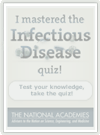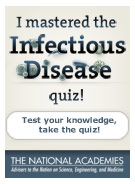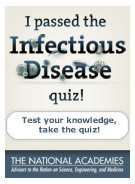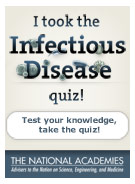
What You Need To Know About Infectious Disease
What do you know about infectious disease?
In 2008, about how many people worldwide were infected with HIV (human immunodeficiency virus)?
-
Sorry, that’s incorrect.
In 2008, more than 33 million people worldwide were infected with HIV (human immunodeficiency virus). In that same year, an estimated 2 million people died from AIDS (acquired immunodeficiency syndrome), the final stage of HIV infection.
-
Sorry, that’s incorrect.
In 2008, more than 33 million people worldwide were infected with HIV (human immunodeficiency virus). In that same year, an estimated 2 million people died from AIDS (acquired immunodeficiency syndrome), the final stage of HIV infection.
-
Correct!
In 2008, more than 33 million people worldwide were infected with HIV (human immunodeficiency virus). In that same year, an estimated 2 million people died from AIDS (acquired immunodeficiency syndrome), the final stage of HIV infection.
Since the beginning of the 20th century, the number of people in the world has:
-
Sorry, that’s incorrect.
Since the beginning of the 20th century the number of people in the world has more than quadrupled—from 1.6 billion to nearly 7 billion—and world population is expected to rise to well over 9 billion by 2050.
-
Sorry, that’s incorrect.
Since the beginning of the 20th century the number of people in the world has more than quadrupled—from 1.6 billion to nearly 7 billion—and world population is expected to rise to well over 9 billion by 2050.
-
Correct!
Since the beginning of the 20th century the number of people in the world has more than quadrupled—from 1.6 billion to nearly 7 billion—and world population is expected to rise to well over 9 billion by 2050.
“Antibiotic resistance” refers to:
- The reluctance of physicians to prescribe antibiotics
- An underground movement against pharmaceutical companies
- The ability of bacteria to resist the effects of an antibiotic
-
Sorry, that’s incorrect.
“Antibiotic resistance” refers to the ability of bacteria to resist the effects of an antibiotic. Antibiotic resistance occurs when bacteria undergo a genetic change that reduces or eliminates the effectiveness of drugs or other agents designed to cure or prevent infection.
-
Sorry, that’s incorrect.
“Antibiotic resistance” refers to the ability of bacteria to resist the effects of an antibiotic. Antibiotic resistance occurs when bacteria undergo a genetic change that reduces or eliminates the effectiveness of drugs or other agents designed to cure or prevent infection.
-
Correct!
“Antibiotic resistance” refers to the ability of bacteria to resist the effects of an antibiotic. Antibiotic resistance occurs when bacteria undergo a genetic change that reduces or eliminates the effectiveness of drugs or other agents designed to cure or prevent infection.
Which are larger?
-
Correct!
Bacteria are 10 to 100 times larger than viruses.
-
Sorry, that’s incorrect.
Bacteria are 10 to 100 times larger than viruses.
Public health officials can identify the outbreak of disease by monitoring certain patterns of behavior through syndromic surveillance. Which of the following is one of the signs used to identify a disease outbreak using this system?
- Level of school and work absenteeism
- Sales of over-the-counter medication
- Number of illness-related 911 calls
- All of the above
-
Sorry, that’s incorrect.
In syndromic surveillance, all of the above are used in addition to other patterns that suggest an outbreak. Despite the emergence of this innovative surveillance method, most surveillance still depends on tracking reported infections.
-
Sorry, that’s incorrect.
In syndromic surveillance, all of the above are used in addition to other patterns that suggest an outbreak. Despite the emergence of this innovative surveillance method, most surveillance still depends on tracking reported infections.
-
Sorry, that’s incorrect.
In syndromic surveillance, all of the above are used in addition to other patterns that suggest an outbreak. Despite the emergence of this innovative surveillance method, most surveillance still depends on tracking reported infections.
-
Correct!
In syndromic surveillance, all of the above are used in addition to other patterns that suggest an outbreak. Despite the emergence of this innovative surveillance method, most surveillance still depends on tracking reported infections.
Which of the following is needed to help improve the public health situation in developing countries?
- More safe water supplies
- Better sewage treatment and disposal
- Improved food safety and vaccination programs
- All of the above
-
Sorry, that’s incorrect.
All of the above are urgently needed in developing nations. A major barrier to achieving these improvements is the underlying weakness of health systems in resource-poor countries, including a shortage of health workers and a lack of disease surveillance programs.
-
Sorry, that’s incorrect.
All of the above are urgently needed in developing nations. A major barrier to achieving these improvements is the underlying weakness of health systems in resource-poor countries, including a shortage of health workers and a lack of disease surveillance programs.
-
Sorry, that’s incorrect.
All of the above are urgently needed in developing nations. A major barrier to achieving these improvements is the underlying weakness of health systems in resource-poor countries, including a shortage of health workers and a lack of disease surveillance programs.
-
Correct!
All of the above are urgently needed in developing nations. A major barrier to achieving these improvements is the underlying weakness of health systems in resource-poor countries, including a shortage of health workers and a lack of disease surveillance programs.
True or False: Our bodies contain at least 10 times more human cells than bacterial cells.
-
Sorry, that’s incorrect.
Our bodies contain at least 10 times more bacterial cells than human cells.
-
Correct!
Our bodies contain at least 10 times more bacterial cells than human cells.
True or False: Scientists predict that rising average temperatures in some regions will change the transmission dynamics and geographic range of cholera, malaria, dengue fever, and tick-borne diseases.
-
Correct!
Scientists predict that rising average temperatures in some regions—a result of climate change—will change the transmission dynamics and geographic range of cholera, malaria, dengue fever, and tick-borne diseases.
-
Sorry, that’s incorrect.
Scientists predict that rising average temperatures in some regions—a result of climate change—will change the transmission dynamics and geographic range of cholera, malaria, dengue fever, and tick-borne diseases.
Which of the following diseases is NOT caused by a virus?
-
Sorry, that’s incorrect.
Tuberculosis is caused by a bacterial infection. Chicken pox, the common cold, and influenza are all caused by viral infections.
-
Sorry, that’s incorrect.
Tuberculosis is caused by a bacterial infection. Chicken pox, the common cold, and influenza are all caused by viral infections.
-
Sorry, that’s incorrect.
Tuberculosis is caused by a bacterial infection. Chicken pox, the common cold, and influenza are all caused by viral infections.
-
Correct!
Tuberculosis is caused by a bacterial infection. Chicken pox, the common cold, and influenza are all caused by viral infections.
Thank you for taking our quiz.
Place this badge on your Facebook page to show your friends what you know about infectious disease.
Place this badge on your Facebook page to show your friends what you know about infectious disease.
OR, get a higher score to unlock a different badge.

Place this badge on your Facebook page to show your friends what you know about infectious disease.
OR, get a higher score to unlock a different badge.

Explore Other Topics
Disease Watchlist
Infectious Disease Defined
- Ecology
A branch of science that deals with the relation of organisms to one another and their physical environment.


